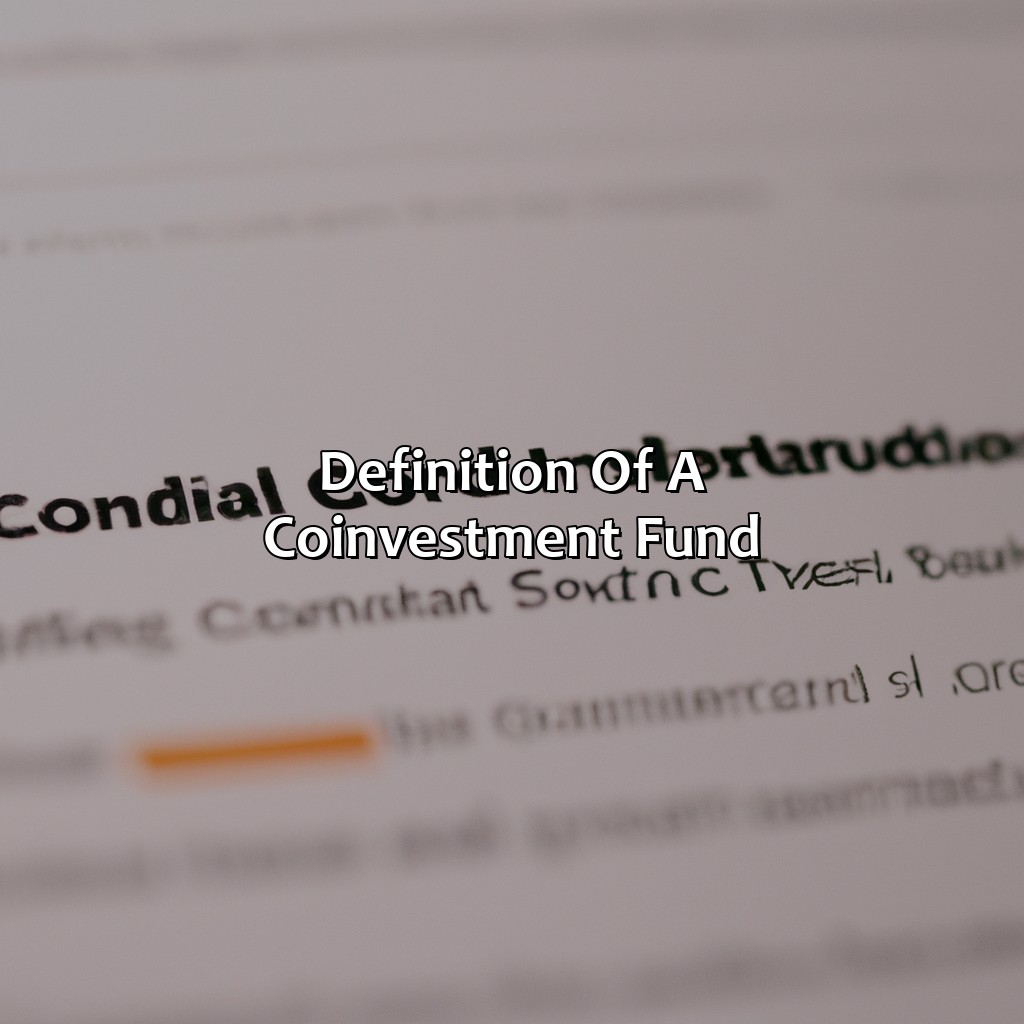What Is A Co-Investment Fund?
Key Takeaway:
- A co-investment fund is a type of investment fund where investors pool their money together to invest in a specific opportunity. It allows investors to access exclusive opportunities that they may not have been able to invest in otherwise.
- Co-investment funds work by matching investors with opportunities and sharing the risks and profits. These funds can take on different structures, including private equity or venture capital funds, and can have different participation requirements.
- Advantages of co-investment funds include access to exclusive investment opportunities, diversification and risk management, and potential cost savings. However, investors should also be aware of the limited control they may have, higher minimum investment requirements, and the risks of underperformance or losses.
Are you looking to diversify your investments? Co-investment funds may be the ideal solution for you. With potential for higher returns but also greater risk, understanding what a co-investment fund is and how it works is essential. You’ll get all the information you need here.
Definition of a Co-Investment Fund
Co-investment funds are investment vehicles formed by a group of investors who pool their funds to invest in a single venture alongside a lead investor. These funds offer advantages such as increased opportunities for diversification, lower investment minimums and shared risk amongst investors.
One benefit of co-investment funds is the ability to gain access to investment opportunities that may not be available to individual investors. These opportunities often have higher minimum investment requirements, making them inaccessible to most investors. Additionally, co-investment funds allow investors to diversify their portfolios by investing in multiple ventures with smaller amounts of capital.
Co-investment funds can have a unique structure, with some funds being managed by a single lead investor who sources deals and makes investment decisions, while others may have a team of managers responsible for sourcing and managing investments.
One notable example of a successful co-investment fund is the New York City Investment Fund. This fund was formed in collaboration with the New York City Economic Development Corporation and has invested in a wide range of local initiatives, from technology startups to affordable housing projects. The fund has been lauded for its role in stimulating economic growth in the city.

Image credits: retiregenz.com by Yuval Woodhock
How Co-Investment Funds Work
Know how co-investment funds work? It’s easy! Just learn how investors match with opportunities, how risks and profits are divided, and what types of co-investment funds exist. This section will give you the answers.
- Matching investors
- Sharing risks and profits
- Different co-investment fund types
Matching investors, sharing risks and profits, and different co-investment fund types will be discussed here.

Image credits: retiregenz.com by David Jones
Matching Investors with Opportunities
The integration of investors with profitable opportunities is the foundation of Co-Investment funds. These funds deploy resources to facilitate investments across various industries while matching investor demands. Partnerships form from vested interest individuals who collaboratively pool their money towards an investment goal.
Co-investment funds provide access to diversified project portfolios that would otherwise not be attainable by an individual investor. The risk and rewards are shared among co-investors utilizing a structured investment strategy. The idea behind this system is that combining a group of knowledgeable investors reduces the risk involved in traditional investments, while opening up broader revenue streams for everyone.
What sets co-investment funds apart from other funds is that partners share involvement in the decision-making process. This provides transparency about where resources are invested and fosters an environment that supports assisting each partner’s needs. Through rigorous evaluations and due diligence measures, investment options could potentially produce higher returns for all parties involved.
A great example of a successful co-investment fund was seen with App Dynamics, which scored big through such an approach when it went public back in 2017. The company relied on funding from private equity firms as well as co-investors, enabling the software application company to grow exponentially, ultimately resulting in being acquired by Cisco Systems Inc for $3.7bn less than six months after going public.
When it comes to sharing risks and profits with a co-investment fund, it’s like having a business partner, but without the awkward small talk and obligation to split the bill at lunch.
Sharing Risks and Profits
Co-Investment Funds entail sharing profits and risks between multiple investors. Here are three points explaining how this works:
- Co-investment funds pool money from different entities to invest in a project or asset, which helps reduce an individual’s investment risk.
- These funds can be established between private equity firms, institutional investors, or individuals looking to diversify their portfolios.
- Co-investors pay lower fees compared to traditional investment vehicles while having direct exposure to the underlying project or asset.
In addition, co-investment funds often involve deals with exclusive access; these deals offer opportunities that can hardly be obtained through publicly traded equities.
Many decades back, limited partnerships were used in the United States of America commonly; they became popular as private equity gained traction. As such, institutional investors utilized limited partnership structures followed by individual investors to spread out risk and pay fewer dues on their investments. Over time, this evolved into the co-investment fund structure we know today.
If you’re feeling adventurous, try the ‘blind pool’ co-investment fund – because investing in something without knowing what it is, is always a good idea.
Types of Co-Investment Funds
Co-investment funds come in various forms. Here are some examples:
| Types of Co-Investment Funds | Description |
|---|---|
| Direct Co-Investment Fund | A fund that invests directly in a particular company. |
| Fund of Funds (FoF) | A fund that aggregates multiple co-investment opportunities into a single vehicle and invests on behalf of other funds or investors. |
| Managed Co-Investment Fund | A type of co-investment fund where an investment manager selects and manages co-investments on behalf of investors. |
Another less common type is syndication co-investment, where a group of investors partner together to make large investments.
It’s essential to note the unique requirements and underlying investment strategies for each type of co-investment funds before deciding which one to participate in.
Are you missing out on lucrative investment opportunities with co-investments? Participating can increase your chances for substantial returns.
Co-investment funds: because sometimes it’s better to have a partner in crime.
Advantages of Co-Investment Funds
Gain an edge in the investment market – opt for the right approach.
Understand the advantages of co-investment funds – exclusive access to investment opportunities, diversification and risk management features.
Plus, achieve cost savings with co-investment funds.

Image credits: retiregenz.com by Adam Washington
Access to Exclusive Investment Opportunities
Co-investment funds provide investors with access to unique opportunities not found in other investment vehicles. These exclusive investment opportunities are only open to investors who have a stake in the fund, making it an attractive option for those looking to invest in high-value deals with potential for significant returns.
In addition, co-investment funds offer exposure to private market investments that are not widely available in public markets, hence providing diversification benefits for the investor while minimizing risks.
Furthermore, as these funds pool resources from various investors towards a specific project or venture, they often have more significant amounts of capital to deploy, enabling them to negotiate more favorable terms and conditions.
Investors can obtain relevant information about the project or company in which they intend to invest before deciding whether or not to participate. Co-investment funds usually expertly manage their investments; therefore, investors benefit from specialized expertise and knowledge transfer.
To capitalize on these lucrative opportunities presented by co-investment funds, interested parties should carry out proper due diligence on each fund’s investment strategy and performance record. Additionally, investors should also actively participate and monitor their contributions’ performance to ensure a profitable return on investment.
“Diversify your investments, because putting all your eggs in one basket is only good for an omelette – and no one wants a scrambled portfolio.”
Diversification and Risk Management
Investing in a co-investment fund can provide great advantages when it comes to managing diversification and risk. By pooling funds with other investors, co-investment funds spread investments over various companies and industries, reducing the impact of any single investment’s performance on the overall portfolio. This, in turn, mitigates risk and ensures that your return on investment is stable.
In addition to spreading risk, co-investment funds allow investors to gain access to a diverse set of opportunities that may not be available otherwise. Investing alongside experienced asset managers provides access to high-quality deal flow and increased partnership opportunities. The cost-effectiveness achieved through economies of scale makes it possible for smaller investors to participate in deals they would not be able to alone.
It is essential to identify the right investment partner because selecting the wrong one may harm long-term gains. An experience-rich co-investment partner will be capable of using their wealth of knowledge about various sectors such as Healthcare, Retail, Industrial & Commercial Real Estate to manage downsides properly while priming companies for upsides.
With limited positions available in carefully selected deals and proven track records, investments with strong returns require diligence and speed in decision-making – leaving FOMO (Fear Of Missing Out) lingering in control.
Consider a co-investment strategy if you prioritize risk management or advancement towards building quality portfolios. Co-investments are multidisciplinary, which gives investors familiarity with different business models by opening new avenues for deal flow. Co-investing: because sharing is caring, especially when it comes to saving money.
Cost Savings
Utilizing Co-Investment Funds Can Lead To Cost-Efficiency
Participating in co-investment funds can provide cost-efficiency benefits to investors. Rather than solely investing in an individual portfolio, investors can pool their resources and share the risk with others who have similar interests. Co-investing allows for lower transaction costs as multiple investors can invest in a single deal, instead of each investor performing due diligence on separate deals.
In addition to saving costs on transactions, co-investment funds present opportunities for investors to diversify their investment portfolios. By combining various assets, investors can mitigate risks and achieve higher returns on their investments. This method also allows individuals to access a wider range of deal flow that they may not have been able to access otherwise.
Investors can maximize the benefits obtained from co-investment by partnering with experienced fund managers who specialize in this space. These professionals often possess specialized knowledge about different sectors and have strong relationships with potential companies or opportunities that could add value to an investment portfolio.
Ultimately, engaging in a co-investment fund has several benefits beyond just cost savings. Investors who take advantage of these opportunities are more likely to build diversified portfolios, increase their chances of higher investment returns and have access to exclusive investment deals they may not acquire through standalone investments.
Co-investment funds: because investing alone is overrated, but losing money in a group just hits different.
Disadvantages of Co-Investment Funds
Investing in co-investment funds carries potential risks. You must consider the drawbacks.
- Limited Control for Investor
- High Min. Investment Requirements
- Risk of Underperformance or Losses – these are areas to explore. Each shows a possible weak spot that could hurt your returns. Knowing beforehand is vital.

Image credits: retiregenz.com by Adam Woodhock
Limited Control for the Investor
Investors in co-investment funds have limited control over the investment decisions. This means that they cannot make individual investments and need to follow the group’s investment strategy. Due to the lack of control, investors may not be able to mitigate risks or maximize returns to their full potential.
In addition to this, co-investment funds may have limited transparency in terms of the specific investments made by the fund. Investors may not have access to information about individual companies or industries in which their money is being invested, making it difficult for them to gauge performance or assess risk.
Moreover, investors cannot exit a co-investment fund easily as they are locked-in for a certain period and may incur high costs if they choose to withdraw their investment prematurely. This can be a significant disadvantage for those who want more flexibility with their money.
To avoid missing out on investment opportunities, investors should carefully consider whether or not co-investment funds align with their investment goals and values. It is essential to conduct thorough research and due diligence before committing any capital into such funds. Investors must also understand the terms and conditions properly before investing along with considering other available options that align better with their goals and priorities.
Finally, higher minimum investment requirements are here to rain on your parade.
Higher Minimum Investment Requirements
Co-investment funds often require a larger threshold of investment, making them significantly more exclusive. This can result in limiting the number of potential investors who possess the prescribed minimum and disallowing smaller investors from participating.
In turn, this reduces diversification, which results in increasing risks for investors with smaller portfolios or less capacity to absorb losses. The greater risk also stems from restricted spread of exposure across various investments within a specific fund.
Moreover, high minimum investment requirements can force firms to prioritize larger-sized investors. This is disadvantageous for the smaller investors who may have varying preferences in terms of investment opportunity and risk levels.
Investors with limited funding should consider alternative investment vehicles that work best for their resource capacity without sacrificing a diversified level of risk management. It is imperative that they explore other viable options before missing out on lucrative opportunities presented by co-investment funds.
Co-investment funds: Because sometimes investing in someone else’s bad decisions just isn’t risky enough.
Risks of Underperformance or Losses
Investing in co-investment funds can lead to possible drawbacks and could result in reduced returns. These downsides may include the possibility of underperformance or losses, which may impact the overall portfolio.
Co-investment funds entail a certain degree of uncertainty as they invest directly in private companies or assets, which are highly volatile and unpredictable. Also, these funds usually do not have diversification benefits that come with traditional mutual funds, thus making them riskier.
In contrast to other alternative investment avenues such as private equity, co-investment deals tend to be smaller and hence leave less room for negotiation over terms and conditions. Additionally, if not chosen carefully, they may provide insufficient liquidity to those investors who need it.
A prime example of the said risks was when Energy Future Holdings (EFH) filed for bankruptcy after KKR, TPG, and Goldman Sachs invested $21 billion towards the company’s leveraged buyout in 2007. This filing resulted in total losses for these three firms’ equity investments around $6 billion.
Some Facts About Co-Investment Funds:
- ✅ Co-investment funds are pooled investment vehicles that allow multiple investors to collectively invest in a single private equity deal. (Source: Investopedia)
- ✅ Co-investment funds provide investors with the opportunity to invest in deals alongside established private equity firms. (Source: Preqin)
- ✅ Co-investment funds typically charge lower fees than traditional private equity funds, making them an attractive option for some investors. (Source: Pitchbook)
- ✅ Co-investment funds are popular among institutional investors, such as pension funds and endowments. (Source: Harvard Business Review)
- ✅ Co-investment funds can offer investors the potential for higher returns due to the direct ownership of assets in a single deal. (Source: Forbes)
FAQs about What Is A Co-Investment Fund?
What is a co-investment fund?
A co-investment fund is a type of investment vehicle that allows multiple investors to invest in a company or project together. Unlike a traditional fund where the assets are managed by a portfolio manager, co-investment funds are structured in such a way that the investors make the investment decisions themselves.
How does a co-investment fund work?
In a co-investment fund, investors pool their money together and invest in a specific project or company. The investor group will typically consist of high net worth individuals, family offices, or institutional investors. Once the investment is made, investors will hold a direct stake in the company or project rather than owning shares in a fund that owns the assets.
What are the advantages of investing in a co-investment fund?
Investing in a co-investment fund can have several advantages. Firstly, investors can have more control over their investments as they are able to make investment decisions themselves. Secondly, co-investment funds can offer higher potential returns than traditional funds as investors are taking on higher risk for higher reward. Finally, co-investment funds can allow investors to diversify their portfolios by investing in a range of asset classes and companies.
What are the risks of investing in a co-investment fund?
As with any investment, co-investment funds come with risks. Investors must have a thorough understanding of the investment and be comfortable with the level of risk involved. If the investment does not perform as expected, investors could stand to lose their capital. Additionally, as co-investment funds are often structured as private investments, they are typically illiquid and may not be easily traded.
How are co-investment funds structured?
Co-investment funds can be structured in a number of ways, depending on the needs of the investors. Some co-investment funds are structured as limited partnerships, allowing investors to limit their liability. Others may be structured as joint ventures, where investors have more control over the investment.
How can I invest in a co-investment fund?
Investing in a co-investment fund typically requires a significant investment and may be restricted to accredited investors. Investors can research co-investment fund offerings through their financial advisor, or through online platforms that specialize in private investments. It’s important for investors to conduct thorough due diligence on any potential investment and understand the risks involved before making a commitment.
